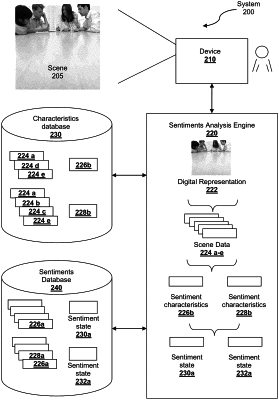| CPC G06Q 30/0269 (2013.01) | 22 Claims |

|
1. A digital sentiment analysis system comprising:
at least one computer readable memory storing software instructions; and
at least one processor coupled with the computer readable memory and wherein the processor, upon execution of the software instructions, performs operations to:
obtain, via a digital sensor, sensor data of an environment, wherein the sensor data comprises at least one digital data modality and at least some data derived by executing a recognition algorithm, wherein the recognition algorithm comprises at least one of the following recognition algorithms: a scale-invariant feature transform (SIFT) algorithm, a Fast Retina Key-point (FREAK) algorithm, a DAISY descriptor algorithm, or a Features from Accelerated Segment Test (FAST) algorithm;
associate one or more sentiment characteristics with at least some of the sensor data, wherein the associating the one or more sentiment characteristics comprises mapping a threshold number or percentage of items present in the sensor data to a sentiment characteristic;
generate one or more digital models of sentiment states in the environment based on at least some of the sensor data and the one or more sentiment characteristics;
determine a set of sentiment states relevant to the environment from the one or more digital models of sentiment states; and
facilitate a mobile device to take action based on the set of sentiment states relevant to the environment.
|